(Black ♀️Congolese) (1,000) https://30kinshasha66.straw.page/
Don't wanna be here? Send us removal request.
Text



Aaliyah for her self titled album photoshoot. — Circa 2001.
8 notes
·
View notes
Note
My dear, I am in a very urgent and urgent matter Please help me buy a new tent to protect us from this cold, wind and rain. Please, the tent was torn over our heads due to the speed of the wind. Please, my friend, donate to me what you can. My children are dying from this extreme cold. Please help me 😥💔💔💔💔💔
i'll try.
0 notes
Note
I'm sorry, I know I'm bothering you, but I really need your help and donations. I need $100, which will save my children's lives. Why do you ignore me so much? Your donation will do a lot for the better. My children are living in great danger due to the consequences of war. Your donation will make a difference to me. Please donate to me. Please don't ignore me. The fate of my children depends on your donation of $100, which will help rebuild my home and build my husband's shop. I hope you don't want to let me down. I would be very grateful for your help
We are in urgent, immediate, humanitarian and very important need for a donation to rebuild what was destroyed by the war, rebuild our home and my husband's destroyed shop, and buy furniture for the house.
Requesting a donation is not easy. I'm sorry. I feel embarrassed to ask for help
You are my only hope and with your help we will build and rebuild our home
#We will rebuild our home and rebuild my family's life again
Donation link
https://gofund.me/3c368bc9
I'll try.
4 notes
·
View notes
Note
To the Tumblr community
•The war has ended, but the suffering continues.
•I will spend the remaining months of my pregnancy🤱 enduring the same hardships.
•We are still living in tents🥺 on the streets
•no homes, no jobs, and no clean water.😥
•We have no source of income, as our workplaces have been destroyed.😔
➡️https://gofund.me/69d9ed7c
€10 can make a difference❣️ 🙏
🛑💵No donation last 3 days👈
✅#am vetted
🟢@gaza-evacuation-funds
🟢@bilal-salah0
🟢@dlxxv-vetted-donatios
🟢@ana-bananya
🟢@khanger
🟢@a-shade-of-blue
i'll try.
0 notes
Note
I'm so tired 😔
I try so hard to draw your attention to our situation and the suffering we still face every day, but no one cares
Please continue to donate because this is our main source of income to provide basic needs and a safe place‼️😓
i'll try.
0 notes
Note
Hello friends ❤️✋
There is nothing left of our goal of $12,000 🎯💓
Less than $220 left 🚨💪
I really hope to achieve today's goal. 😔🇵🇸🍉
Please donate even a small amount of money in this urgent situation 🙏😞💚
Thank you so much 🍉🇵🇸
https://gofund.me/abbc2759
i'll try.
1 note
·
View note
Note
This is what winter does to my family I swear to God, I just want to live in safety. Please help me and put yourself in my place in this cruel war. Thank you, whatever your religion This is the support link in my name. Make sure I am not fake
https://www.gofundme.com/f/help-me-save-my-family-my-childhood
its okay i'll boost it for you
1 note
·
View note
Text
Save my orphan children

I am Inas, a mother of two young children: Muhammad, 7 years old, and Hala, 5 years old. They should have been living their childhood like all children—safe and warm in the embrace of their father. But the war has stolen that dream from us😭😭😭
Six months ago, my husband Anas, a kind-hearted man who endured a life of poverty, was killed by a random shell while on his way to work as a taxi driver. Since that tragic day, I’ve been left to carry the unbearable weight of life alone.




I held a diploma in international secretarial studies and was about to start a job to help support my family. But the war shattered not only our home but also my hopes and dreams. We’ve been displaced six times and now live in a tent that offers no shelter from the bitter cold or the ever-looming fear.
My young children face relentless hunger that weakens their fragile bodies and a cold that knows no mercy for their small hearts. Each day, their cries for warmth and food grow louder, and each day, I feel more helpless to provide them with even the basics of life💔😭😭

I appeal to your humanity, to your compassion. We need your help to survive, to find a safe shelter, and to feed my children. Your generosity could be the reason Muhammad and Hala continue to live and find hope amidst this darkness🥹


Please, help me keep the light of these innocent children from being extinguished by this cruel world
Donation Link
12K notes
·
View notes
Text
MOGAI BHM- Belated Day 15!
happy BHM! yesterday, i gave a more general overview of the Black Power movement- and today, i’m going to be talking more about key groups and individuals from that movement and that general time period, especially Malcolm X and the Black Panther Party!
Malcolm X-
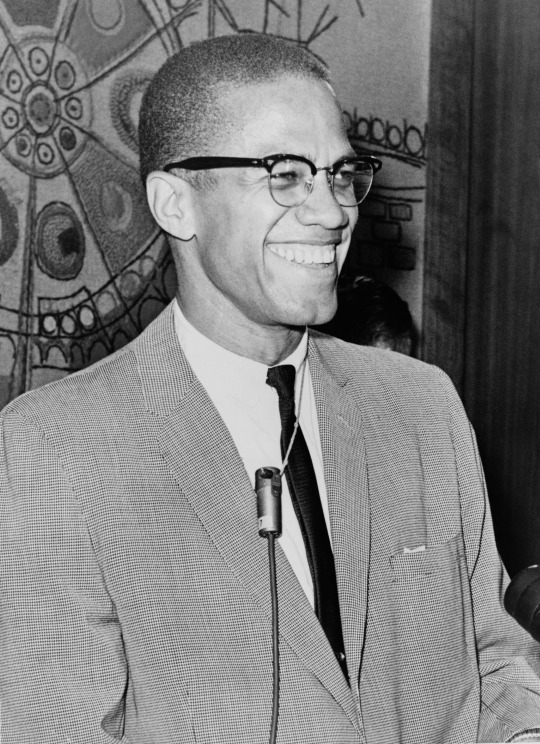
[Image ID: A black-and-white photograph of Malcolm X, a thin, Black man. He has short, almost buzzed hair, and in the photo, he is smiling very widely, wearing black glasses and a black necktie with a white collared undershirt and a boxy grey suit jacket, and he has a mic extending from his face. End ID.]
The sentiments and progression of the Black Power movement were hugely influenced and inspired by Malcolm X. Although he was murdered before he got the chance to see the Black Power movement begin to grow and flourish, he is an integral part of its history.
Born in 1925, Malcolm X grew accustomed to horrid racist violence from early on. His father, Earl Little, was an active member of the Universal N*gro Improvement Association (UNIA), which meant that the KKK frequently targeted his family, causing them to have to move twice to flee violence- but it got worse everytime they moved. His father was later murdered, though his death was never investigated and just reported by the all white police as a streetcar-related accident.
Tragically, Malcolm’s mother was so impacted by all of this that her mental health suffered and she was institutionalized, forcing Malcolm and his siblings to be separated by the foster system. Malcolm had a somewhat troubled early life, and he ended up incarcerated for nearly a decade- and during that time, he converted to the Nation of Islam, a small group of Black Muslims who were dedicated to spreading Islam within the Black community.
It is with the Nation of Islam that Malcolm X rose to great fame. He changed his name to Malcolm X after prison, and became an active part of the Nation of Islam, which aligned itself with the Black nationalism from the likes of Marcus Garvey, who had inspired Malcolm since he was young. He worked with the leader of the Nation of Islam, Elijah Muhammad, and he, along with becoming the minister of several Temples, founded several of his own Temples.
In 1960, Malcolm established the magazine ‘Muhammad Speaks’ to further spread Islam. Through the likes of this magazine, Malcolm X established the sentiments for which he is famous. He is known for saying that “there is no such thing as a nonviolent revolution” and that Black people should “cast off the shackles of racism by any means necessary”. During the Civil Rights Movement, Malcolm X’s fame built the foundations for the Black Power movement.
Malcolm X believed that nonviolence was not the answer and in fact was part of the problem. His was part of a more radical mindset that acknowledged that Black people shouldn’t have to respond to the violence they experience with nonviolence in order to be respected. He believed that nonviolence just enforced respectability politics- if Black people experience senseless violence and persecution, why should they have to be the ones to show restraint? Malcolm’s beliefs were radical for the time, and were a huge part in growing the membership of the Nation of Islam to huge numbers. Malcolm’s call for the liberation, not the assimilation, of Black people, echoed throughout the Black Power movement.
Malcolm’s beliefs and influence made him have many, many devout followers- and many, many devout critics, including Martin Luther King Jr. himself. The two didn’t see eye to eye at all, and fought about the best methods of Black liberation. Malcolm’s fame took him all over the country, giving speeches and sermons at HBCUs and other venues.
In 1964, Malcolm X split with the Nation of Islam after experiencing a fallout with Elijah Muhammad. He embarked on a journey across North Africa and returned with a different belief system, believing more in nonviolence than before. This was brief though, as he was violently assassinated by three members of the Nation of Islam on February 21, 1965. Malcolm’s fame and influence during his lifetime ushered in the Black Power movement that followed his tragic death. His influence helped largely to shift from usage of ‘n*gro’ and ‘colored’, to ‘Black’ and ‘Afro-American’ to refer to Black Americans.
Kwame Ture-

[Image ID: A black-and-white photograph of Kwame Ture, a thin Black man, standing at a podium with several microphones. He is wearing a black suit jacket over a white collared undershirt with a fancy, patterned black necktie, and is pumping both fists in the air in a celebratory gesture and looking upwards. End ID.]
Formerly named Stokely Carmichael, Kwame Ture was the man who today is pretty unanimously credited with being the “father” of the Black power movement. A graduate of Howard University, a famous HBCU, Kwame, who in 1968 named himself after two of his close friends and political allies, Sekou Toure and Kwame Nkrumah, was a firm believer in Black nationalism, and especially Pan-Africanism- a movement to create a singular Black American identity of pride, to acknowledge pride of being of African descent.
Kwame was heavily involved in the Civil Rights Movement in the early 1960s. During this time, he participated in the pivotal Freedom Rides, and he joined the Student Nonviolent Coordinating Committee and participated in their sit in movement. This marked the beginning of his time with the SNCC, of which he was eventually elected chairman in 1965, which symbolized an official SNCC shift in ideology from nonviolence to more radical Black nationalism.
While with the SNCC, Kwame Ture campaigned as part of their voting rights campaign, which resulted in the creation of the Lowndes County Freedom Organization, which pushed for voter registration and Black candidates in Lowndes County, Alabama, a county with 80% Black citizenship but 0% Black voter registration. Though initially unsuccessful, this organization was very influential and led to the growth of similar organizations throughout the country- and it also was the precursor to the Black Panther party. The black panther symbol has long been a symbol of Black power, and it was first adopted as a symbol by the Lowndes County Freedom Organization, and was later, with permission, adopted by the Black Panther Party itself.
In March of 1966, after years of growing tension between the SNCC and the SCLC, between the principles of nonviolence and the principles of Black nationalism, Kwame Ture led a march known as the March Against Fear where he officially cried and claimed “Black power”. After this point in time, he began professing Black power publicly and defining and shaping the phrase. In 1968, Kwame was named the honorary prime minister of the Black Panther Party.
After his work with the SNCC, Kwame Ture spent the rest of his life campaigning for racial justice abroad, notably travelling and campaigning to form the All African Peoples Revolutionary Party.
The Black Panther Party-
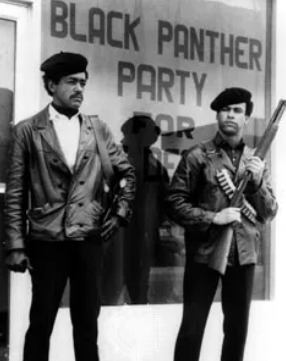
[Image ID: A black-and-white photograph of Bobby Seale and Huey Newton, two Black men. They are both wearing button-up leather jackets over white collared shirts, black pants, and black berets, and are standing with their rifles in front of a banner that says “BLACK PANTHER PARTY…”. The rest of what it says is not discernible in the image. End ID.]
Perhaps the most famous group to come out of the Black Power movement was the Black Panther Party for Self Defense, or the BPP. It was founded on the premise that, if the state wasn’t going to protect and serve its Black citizens, then Black people would have to do it themselves- the concept of self defense and self determination in the most literal sense.
Outraged by the assassination of Malcolm X, two men, Huey Newton and Bobby Seale, met in Oakland in 1966 to form what became the Black Panther Party. Its original purpose was to provide armed self defense to Black neighborhoods against potential acts of white supremacist violence and police brutality. One of its principal ideas was the belief in the arming of all Black Americans so they could be prepared to defend themselves against attacks- so armed self defense became common tactics employed by the many chapters of the BPP that popped up in large cities across America.
The Black Panther Party also operated free breakfast programs for Black children who couldn’t afford expensive school meals, and they offered protection to Black children attending integrated schools. They provided free clothing, food, and transportation to Black people living in poverty, and they called for the freeing of all Black people from all jails, and helped to popularize demands for reparations to be made to Black individuals and communities. Under leadership of local chapters, the BPP opened and ran health clinics for Black Americans.
One radical founding belief of the Black Panther Party was the idea that all oppression, globally, stems from the economic exploitation that exists under capitalism, and that therefore, the abolition of capitalism was the solution to all oppressions. This belief was evident in all of their survival programs and their focus on organizing impoverished Black people to advocate for themselves. Most of their organizing and activism centered around poor Black communities- providing them healthcare, food, clothing, and transportation. They also contributed to the ongoing cause of Freedom Schools and voting registration for Black Americans.
One very notable thing about the Black Panther Party is its Ten-Point Program, which it issued as an outline for the goals of Black liberation, both in general and specifically their goals. This program was, and is, revolutionary because it shows how the foundations of class solidarity lay within the foundations of Black liberation. The ten-point program outlined that education and shelter should be available to all, that reparations should be made, that Black men should be exempt from the draft, that Black people should be given fair trials and treatment within the justice system, that police brutality must be ended, and that Black people deserve equal employment opportunities and the chance to learn about their own history in their schools.
The BPP was the subject of much harassment and suppression by the US government. Huey Newton himself was shot and imprisoned, and the FBI jailed many members and considered them the “number one enemy to national security”. They felt so threatened by Black Power and the BPP that they suppressed them viciously. This resulted in campaigns like the ‘Free Huey’ Campaign.
To this day, the Black Panther Party remains a paradigm for Black pride, Black power, Black nationalism, and Black self determination.
Black Women in the Black Power Movement-
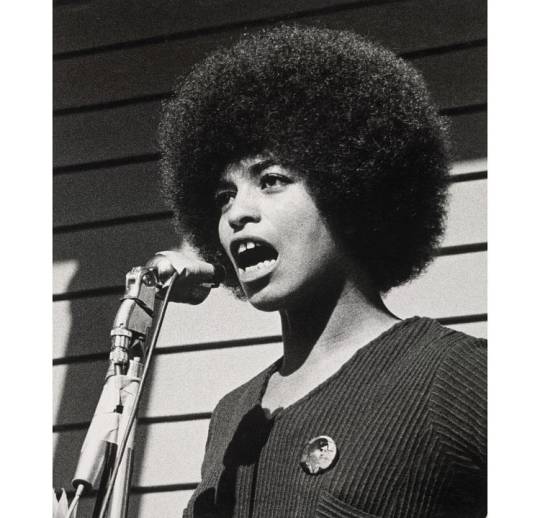
[Image ID: A black-and-white photograph of Angela Davis, a thin Black woman with an afro. In the photo, she is wearing a black long sleeved shirt with a pin on it, and she is standing in front of a microphone into which she is passionately speaking, her mouth open wide. End ID.]
Black women are often ignored and erased from history at large, and that is sadly also true for the history of the Black Power movement. During the 1960s, 70s, and 80s, many forms of mainstream feminism became very popular and gained fame and successes- but many of them excluded and worked against the interests of Black women. Growing Black Power, Black pride, and Black nationalist sentiments combined with rage against anti-Black white feminism, leading many, many Black women to get involved with and help sustain Black Power as a movement.
Despite issues of misogynoir within the Black Panther Party, large amounts of Black women joined their ranks. Many, like Ericka Huggins and Kathleen Cleaver, took on leadership roles, founded and led their own chapters of the BPP. During the Black Power movement, Black women formed both formal and informal networks of other Black women to connect with each other, across the country and across the world. They opened their own beauty shops, barbershops, businesses, and organizations.
During the Black Power movement, masses of Black women joined organizations like the BPP and the National Welfare Rights Organization, and they also created their own organizations. One such organization was the Black Women’s United Front, which was formed by more than 500 women, most of them Black, when they gathered in Detroit on January 25, 1975 to discuss the needs of Black women within a framework of global Black nationalism and liberation. They were dedicated to “abolition of every possibility of oppression & exploitation.” The BWUF developed out of the activism of Black women from the CAP, a national coalition of Black Power and civil rights organizations. Women from these organizations created their own writing columns in newspapers and magazines, handbooks, and guides for Black female liberation.
In 1968, the SNCC held a caucus called the Black Women’s Liberation Committee, where they discussed the misogyny that Black women faced from within the civil rights movement, including from Black men. This caucus developed into the Black Women’s Alliance, and then eventually the Third World Women’s Alliance, which worked to challenge the discrimination Black women faced from many Black men on the grounds of their womanhood.
A key Black woman figure from the Black Power movement is Angela Davis, a member of the BPP and the Communist Party, who was very radical and was jailed for alleged involvement in a murder of a white prison guard, which inspired the famous ‘Free Angela Davis (and all political prisoners)” campaign. She came out as a lesbian in 1977 and to this day is a professor and activist for intersectional justice.
Black women reframed Black Power as a movement of justice and liberation not just racially, but gender and sex wise as well.
Summary-
Malcolm X was a radical Black revolutionary. His work with the Nation of Islam popularized Black nationalist thought and led to the growth of the Black Power movement. He advocated for liberation “by any means necessary”.
Kwame Ture laid the foundations for Black Power as a movement when, as chairman of the SNCC, he chanted Black Power at a march and began organizing for Black Power
The Black Panther Party was a radical, Black revolutionary group aimed at abolishing capitalism. They provided survival programs for Black communities, armed defense in Black neighborhoods, and influenced Black pride and self-determination across the world
Women were a huge part of the Black Power movement. Through founding groups like the Third World Women’s Alliance and the Black Women’s United Front, and through leadership with the BPP and other groups, they revolutionized Black liberation and feminism by providing an intersectional lens.
tagging @metalheadsforblacklivesmatter @intersexfairy @cistematicchaos
Sources-
https://www.biography.com/activists/malcolm-x
https://www.britannica.com/biography/Malcolm-X
https://www.blackpast.org/african-american-history/carmichael-stokely-kwame-ture-1941-1998/
https://www.blackpast.org/african-american-history/lowndes-county-freedom-organization/
https://www.archives.gov/research/african-americans/individuals/stokely-carmichael
https://www.aaihs.org/the-women-at-the-heart-of-black-power/
https://www.archives.gov/research/african-americans/black-power/women
https://www.aaihs.org/abolition-of-every-possibility-of-oppression-the-black-womens-united-front/
https://ncnw.org/ncnw/our-history
https://findingaids.smith.edu/repositories/2/resources/931#:~:text=The%20Third%20World%20Women’s%20Alliance%20(TWWA)%20operated%20from%201968%2D,within%20the%20movement%20against%20racism.
https://oxfordre.com/americanhistory/display/10.1093/acrefore/9780199329175.001.0001/acrefore-9780199329175-e-212;jsessionid=29F8C7B1926662FCF6D0310A0EACD262
https://nmaahc.si.edu/explore/stories/black-panther-party-challenging-police-and-promoting-social-change
181 notes
·
View notes
Text
With vanilla extract being a meme, I wanted to share some black history of Edmond Albius a black slave who revolutionized vanilla pollination.
He used a technique he learned of pollinating melons to polinate the orchids to create the vanilla beans. Vanilla was rare and a luxury mainly due to only being able to be pollinated by its natural pollinator in Mexico.
unfortanely, he didnt receive any money for his discovery despite being called the main man who revolutionized pollination, he died in poverty...

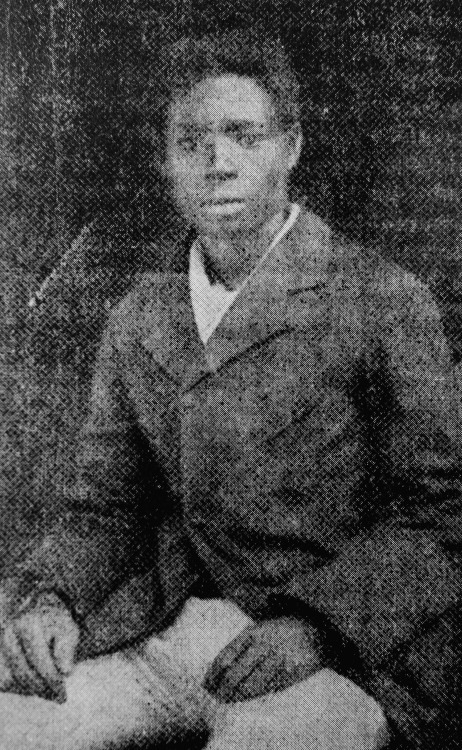
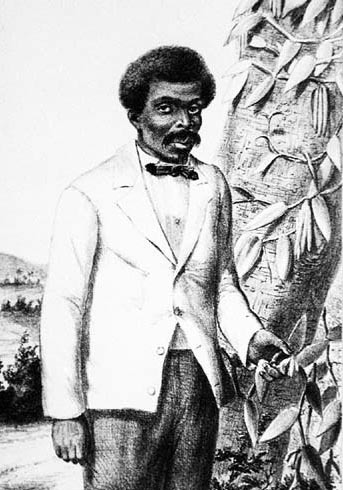
everyone say thank you Edmond
88K notes
·
View notes
Text

Real talk do we fuck with afro brazilian Nauls?
#nauls#so nobody fw with afro brazilian Nauls?#oh okay#thought he was you lots favorite.#guess not.#the thing 1982
9 notes
·
View notes
Text
Real talk do we fuck with afro brazilian Nauls?
9 notes
·
View notes
Text
Real talk do we fuck with afro brazilian Nauls?
9 notes
·
View notes








